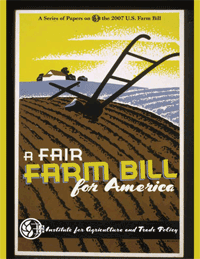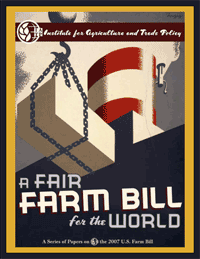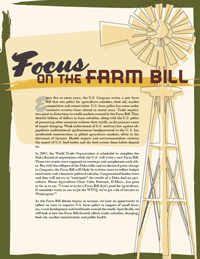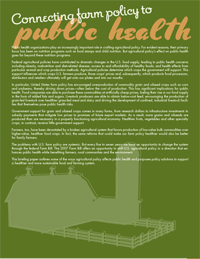publishing
Understanding the Farm Bill
In response to this previous post, Matthew Foster sends this great link to a series of publications dissecting the 2007 Farm Bill. Check the right hand column of the page under “Understanding the Farm Bill.” Matthew is a graphic designer at the Institute for Agriculture and Trade Policy and has done a fantastic job. The bold WPA-inspired graphics and typography make me want to pick up these reports. They evoke an nostalgic image of the American farmer back before it was big Agribusiness. The reports provide overviews of the Farm Bill and its implications as well as IATP’s policy recommendations to make the Bill fairer for the U.S. and the world. A beautiful and compelling way to spread the word on an often overlooked and vitally central policy matter.
Yeah, my current blog design uses WPA imagery, too. What can I say. :-)

Other People
Where design meets activism, one often runs into questions of persuasion.
Via Mike’s snippets I found Following the Crowd to Save the Planet, an article on influence, persuasion, and the social psychology of environmental action. In a nutshell, though people rank “because neighbors are doing it” lowest on a scale of motivational reasons for household conservation, actual data indicates that this is in fact the highest.
“[Researchers] placed one of four cards in each guestroom:
- ‘Help Save The Environment,’ with information stressing respect for nature.
- ‘Help Save Resources For Future Generations,’ with information stressing the importance of energy-saving.
- ‘Partner With Us To Help Save The Environment,’ with information urging guests to help the hotel preserve the environment.
- ‘Join Your Fellow Citizens In Helping To Save The Environment,’ stating the majority of hotel guests reuse their towels.
Compared with the first three messages, the final one asking guests to join others increased towel reuse by about 28 percent.
...
But it’s not fool-proof. The scientists erected signs in the Petrified Forest in Arizona. One sign showed a scene of three wood-taking thieves, with text that urged visitors not to take any wood. After passing this sign, park-goers were three times more likely to steal than the average visitor.
‘The subtext message is that everybody is doing it, which legitimizes the behavior,’ [Robert] Cialdini said.
The second sign showed a lone thief with the same anti-thieving text. Passersby were half as likely to steal as those who didn’t read that sign. The secret to a successful deterrent is to avoid validating deviant actions of a small minority.”
(And note the visual overriding the written message!)
Call for Entries: Graphic Work: Imaging Today’s Labor Movement

The American labor movement has an amazing history of graphic production, creating some of the most effective political images in the history of this country. However, work and workers, along with the labor movement, are often depicted as experiences of the American past: photographs of children in factories in the early 1900’s, paintings of Joe Hill or Rosa Parks, historic strikes and Rosie the Riveter.
Now the labor movement needs new images of the issues confronting workers today. We are asking innovative artists to create posters that relate to today's workers. Twenty-five posters will be chosen to exhibit. Five designs will be selected for mass printing and distribution in union halls, schools, and community centers around the country.
Continue reading "Call for Entries: Graphic Work: Imaging Today’s Labor Movement" »
Factors
“A study reported in Science by researchers at the University of British Columbia found that women exposed to bogus scientific theories linking their gender to poor math skills performed more poorly on subsequent math tests.” More. (via)





